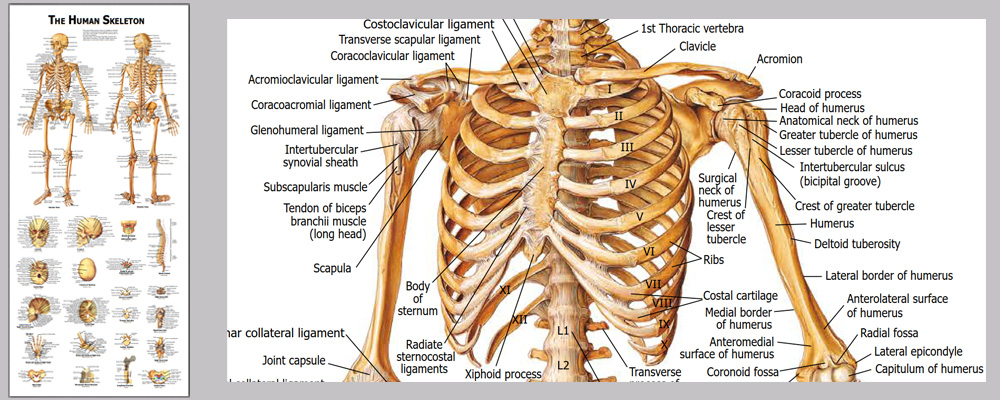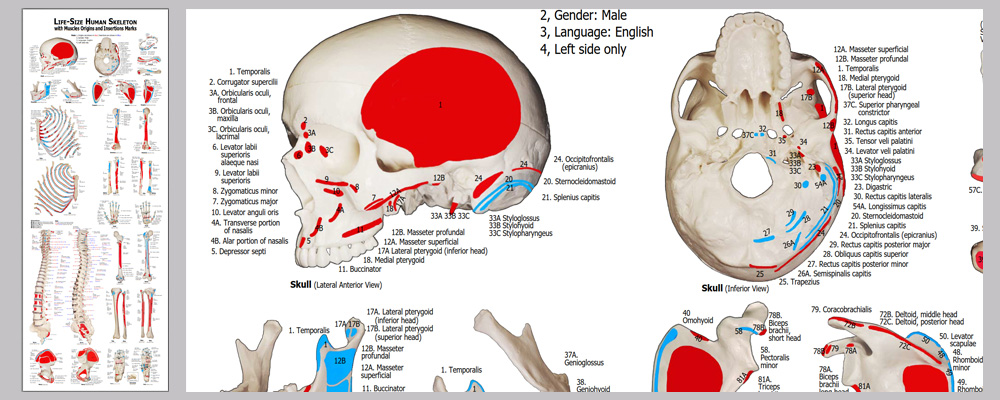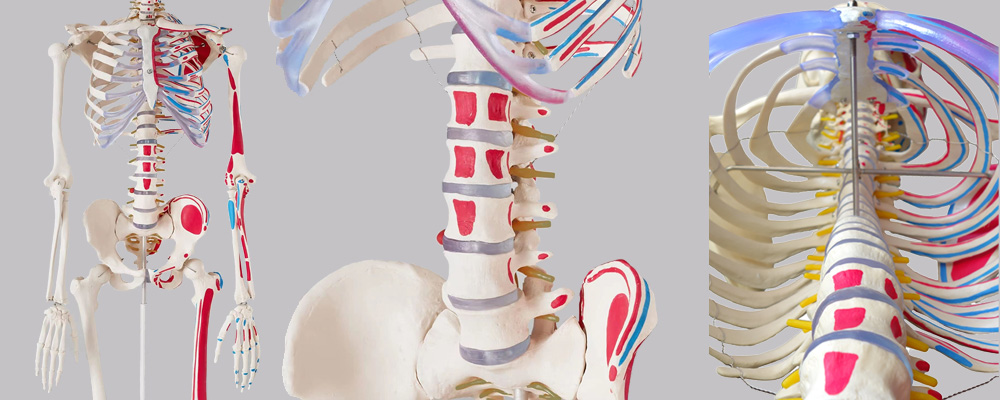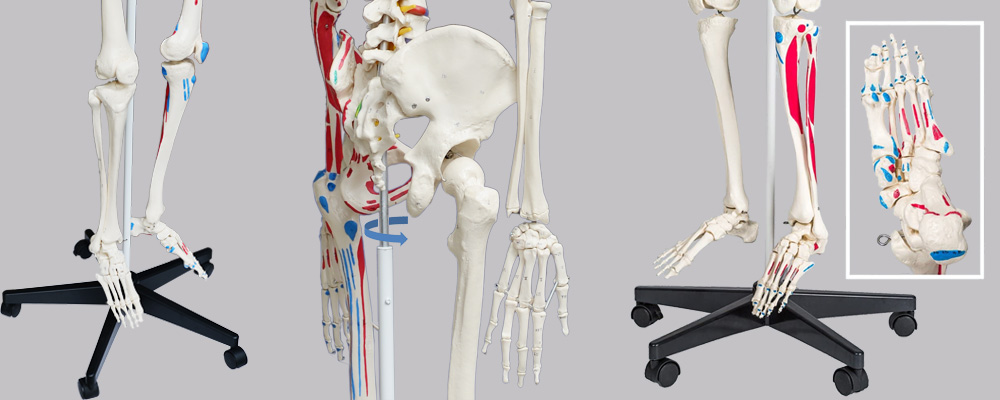human torso anatomical model
This life size articulated adult human skeleton model is 180cm tall & ideal for teaching / learning the basics of human anatomy. Includes a colorful Human Skeleton chart to show all the detailed structures for reference.Detailed colorful chart with over 630 accurate definitions. Durable and no reflection with matte film covered, 36 * 78cm

Detailed muscles origins and insertions with codes. Durable and no reflection with matte film covered, 100cm * 38cm

Stainless steel wires keep the ribs gaps stable.

2 of 5 casters are lockable.

An overview of JC anatomy advantages: • Hand-painted muscle origins and insertions • Flexible spine and ligaments • Slipped disc between the 3rd and 4th lumbar vertebrae • Protruding spinal nerves and vertebral arteries • 3-part assembled skull with individually inserted teeth • Made from a durable, unbreakable synthetic material • Top quality, life size natural casting • lMultiple Applications -physiotherapist,human movement,physiotherapist, etc. • lChart - Detailed colorful chart with about 701 accurate definitions. Durable and no reflection with matte film covered, 36 * 78cm • On a stable metal stand with 5 casters (painted white) • Full size dust cover keeps model clean while in storage • Exceptional value for money with a 3 year guarantee • human torso anatomical model Easy to use - Main joints are movable. Skull, skullcap arms, legs, crus, feet are removable.
| Product name | human torso anatomical model |
| Place of Origin | Shenzhen China |
| Product Material | PVC, ABS, SST |
| Rib cage | A 5mm dia |
| Human skeleton model life | 13years |
| Surface treatment | Polish. Etched. Texture |
| SUPPORT 24/7 | Contact us 24 hours a day, 7 days a week |
| Size | 67 * 67 * 94 |
| Port | Shenzhen |
| PAYMENT & ORDERING | PayPal account or pay by credit card |
human torso anatomical model FAQs Guide Are you looking for a quick review guide about human torso anatomical model? An ultimate FAQs buying guide is available to help you.This guide contains all the information about all the important facts, figures, and various processes regarding human torso anatomical model. Let’s continue!
2.Does this human torso anatomical model include all human skeletal systems?
3.Is it possible to disassemble different parts of this human torso anatomical model?
4.Can the human torso anatomical model display many different body poses?
5.human torso anatomical model Can it be used as a teaching aid?
6.Can this human torso anatomical model be used as an aid to human learning?
7.What are the different types of human torso anatomical model available?
8.Is it possible to color code this human torso anatomical model to represent different bone parts?
9.Does the manufacturer of this human torso anatomical model provide relevant anatomy teaching materials?
1.How many movable joints does human torso anatomical model have?
There are approximately 13 movable joints in the human skeleton model, with different types of joints including ball and socket, hinge, pivot, gliding, and saddle joints. These joints allow for a wide range of movements, such as flexion, extension, rotation, abduction, and adduction.
2.Does this human torso anatomical model include all human skeletal systems?
It depends on the model in question. Some Human skeleton models may include all human skeletal systems such as the axial skeleton (skull, vertebral column, ribcage), appendicular skeleton (arms, legs, shoulder girdle, pelvic girdle), and cartilaginous skeleton (cartilaginous structures such as the nose and ears). However, others may only include certain systems or be limited to specific areas of the body. It is important to carefully read the product description or ask the manufacturer for a detailed list of what is included in the model to ensure that it meets your needs.
3.Is it possible to disassemble different parts of this human torso anatomical model?
It's easy to disassemble the whole model into some sub-assemblies - Skull, torso, extremities, etc toollessly. The model can be disassembled into more pieces with tools (Not recommended)
4.Can the human torso anatomical model display many different body poses?
The Human skeleton model can display many different body poses in order to show the movement and positioning of bones and muscles. The model can be manipulated into a range of poses such as the classical anatomical position, where the arms are down by the sides, palms facing forward, and feet shoulder-width apart. It can also be posed to demonstrate actions such as walking, running, jumping, and sitting. The flexibility of the model allows for a wide range of movements to be shown, from simple movements of individual joints to complex combinations of actions involving multiple joints. Additionally, the model can display different body poses by adjusting the positions of individual bones and joints. For example, the arms can be raised or lowered, the elbows bent or straightened, and the fingers spread or closed. The legs can be straightened or bent at the knee, and the ankles can be rotated to show different directions of movement. These adjustments allow for a variety of poses to be demonstrated, from relaxed positions to more dynamic and active positions. In summary, the Human skeleton model can display a wide variety of body poses and movements, ranging from simple to complex, to showcase the functions and interactions of the bones and muscles in the human body.
5.human torso anatomical model Can it be used as a teaching aid?
Yes, a human skeleton model is a commonly used teaching aid in various academic fields such as anatomy, biology, and medical education. It is an accurate and detailed representation of the human skeleton, providing a visual aid for students to understand and grasp the complexities of the skeletal system.
6.Can this human torso anatomical model be used as an aid to human learning?
Yes, this Human skeleton model can be used as an aid to human learning in various ways. It is a representation of the human skeleton, which is the framework of bones that supports the body and protects internal organs. This model can be used as a hands-on learning tool in classrooms, medical schools, and other educational settings. Firstly, it can be used to help students understand the structure and functions of the human skeleton. By examining the bones and their placement, students can learn about the different types of bones, such as long bones, flat bones, and irregular bones, and how they work together to facilitate movement and support the body. This model also allows students to visualize the various joints, their types and movements, and how they are connected to each other. Overall, this Human skeleton model can be a valuable tool in human learning as it provides a tangible and visual representation of the skeletal system. It allows for interactive and hands-on learning, making it easier for students to grasp complex concepts. With its versatility and usefulness in different disciplines, it can serve as an effective aid in enhancing human learning.
7.What are the different types of human torso anatomical model available?
1. Anatomical Skeleton Models: These models are exact replicas of the human skeletal system and are used for educational and medical purposes. They are typically made of high-quality materials such as plastic or resin and come with detailed labels for each bone, making it easy to identify and study different structures. 2. Disarticulated Skeleton Models: These models consist of individual bones that can be separated from each other. They are often used in classrooms for teaching purposes as they allow students to handle and study each bone individually, facilitating a more hands-on learning experience. 3. Flexible Skeleton Models: These models are made from a flexible material such as rubber or PVC and are designed to mimic the movements of the human body. They are often used in medical training and rehabilitation settings to demonstrate muscle and joint movements. 4. Life-size Skeleton Models: As the name suggests, these models are the same size as an actual human skeleton. They are most commonly used in medical schools and hospitals for teaching and training purposes.
8.Is it possible to color code this human torso anatomical model to represent different bone parts?
Yes, it is possible to color code a human skeleton model to represent different bone parts. This can be done through the use of different colored paints, markers, or even colored stickers. The specific colors used will depend on the preferences of the person creating the model and the level of detail they wish to include.
9.Does the manufacturer of this human torso anatomical model provide relevant anatomy teaching materials?
Yes, we provide a series charts to support teaching and learning




